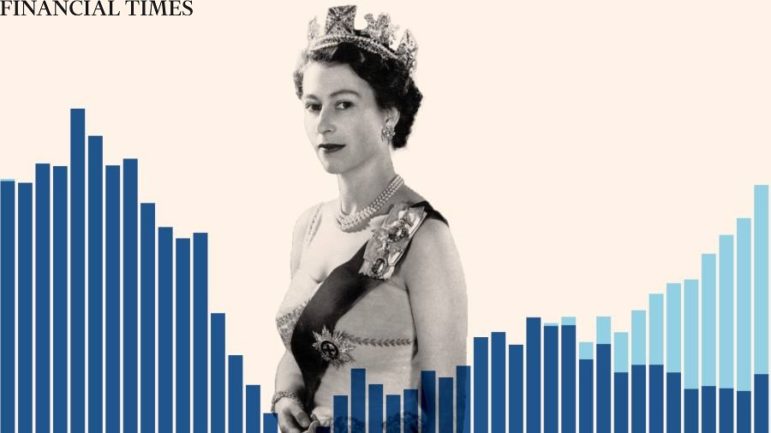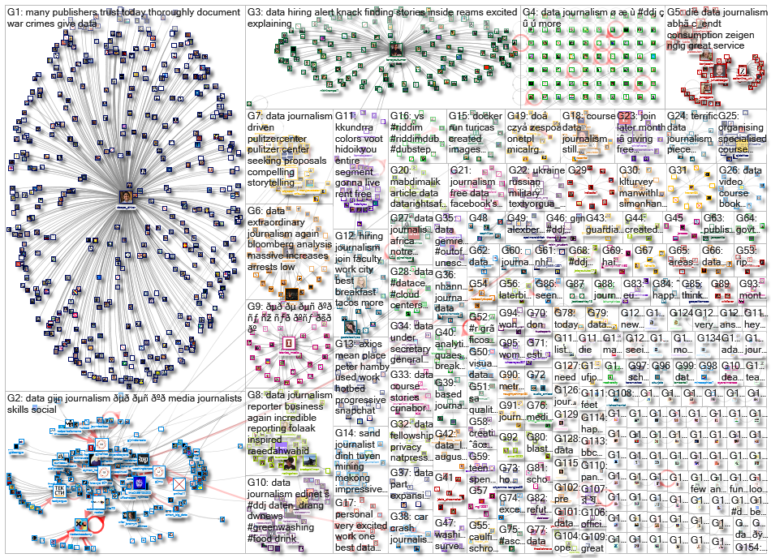
Financial Times charts the changes in UK’s economy, politics, and society during Queen Elizabeth II’s 70-year-reign. Image: Screenshot
As thousands of people wait in a very long queue in London to pay their respects to recently deceased Queen Elizabeth II, newsrooms around the globe have been publishing new charts, or updating old ones, about the monarch’s 70-year-long reign. Our weekly NodeXL and human curation of the most popular data journalism stories on Twitter features The Financial Times’ 10 charts visualizing developments in the United Kingdom during Elizabeth’s reign, The Marshall Project’s look at how government COVID-19 relief funds were used, The New York Times’ investigation of Hasidic religious schools, and Taiwan Data Stories’ scrollytelling project about iconic street food.
Charting the Reign of Queen Elizabeth II
Queen Elizabeth II, the longest reigning monarch in British history, died on September 8, 2022, at 96 years old. In her seven decades on the throne, there have been significant changes in the UK’s economy, politics, and society. The Financial Times presents these developments in 10 charts. Among their findings: migration became the dominant reason for population growth after 2000, family structures evolved to include more divorced people, single-parent families, and same-sex civil partnerships, and female graduates, once a rarity, have now become the majority. Meanwhile, French daily LeMonde visualized all the political leaders in power in the UK, US, Germany, France, Russia, and China during Elizabeth’s reign. Also popular: Amy O’Kruk, NBC’s data visualization and multimedia producer, posted a tweet thread of the different ways several newsrooms visualized the British royals’ line of succession.
Some great charts in this @FT article – they highlight the fundamental changes in the UK’s family, societal & economic structure since the 1950s. Worth a read!https://t.co/eBTxoqDsFa
— Abi Adams-Prassl (@abicadams) September 11, 2022
Where COVID-19 Relief Funds Went
US President Joe Biden’s administration earmarked US$350 billion as COVID-19 relief and recovery funds for state and local governments as part of the American Rescue Plan Act (ARPA). A year later, data analysis by The Marshall Project found that billions of these dollars were directed to the criminal justice system: the police, prisons, and courts. Some local governments justified such spending by explaining that the purchase of equipment and investment in construction or renovations would help to better isolate or segregate individuals in order to curb the spread of COVID-19.
A @MarshallProj analysis by me, @Weihua_Li1 and @susie_c, searched 43,000 reports that local governments submitted to the Treasury, and discovered that much of #ARP money is being spent on the criminal justice system. https://t.co/MeF83GrT7w
— Anastasia Valeeva (@anastasiajourno) September 7, 2022
New York’s Failing Hasidic Schools
Hasidic Jewish religious schools in New York City are private institutions that are subject to little government oversight. In 2019, one such school gave more than 1,000 of its students state standardized tests in reading and mathematics. Every student failed. A troubling year-long investigation by The New York Times found that city Hasidic schools receiving public funds were not providing adequate education in secular subjects, resulting in graduates who were not taught basic science principles and were unable to speak or write in English. For this story, which the Times also translated into Yiddish, journalists interviewed 275 people, reviewed thousands of pages of public records, and analyzed dozens of internal Yiddish-language school documents.
NEW: An NYT investigation has found that scores of Hasidic Jewish schools in New York are purposely denying some 50,000 students a basic secular education – and have received $1 billion in taxpayer dollars over the last 4 years. w/ @brianmrosenthal https://t.co/mjODtkjiMr
— Eliza Shapiro (@elizashapiro) September 11, 2022
Growing Arctic Fires
Climate change is causing temperatures in the Arctic to rise faster than the global average, and wildfires in the region release a disproportionately large amount of greenhouse gases because of the carbon-rich organic soil. An analysis by Reuters found that the share of emissions from wildfires in high latitudes or northern areas has been growing since monitoring began in 2003, accounting for almost one-third of the global wildfire emissions last year.
🔥 Our analysis shows how #wildfires in the boreal forests and tundra of the world's highest latitudes are responsible for a growing share of global fire emissions.
— Reuters Graphics (@ReutersGraphics) September 8, 2022
Ukraine Counteroffensive Reclaims Territory
Last week, Ukraine’s army made its most significant advance against Russian forces in months, since the invasion in February. According to military analysts and satellite imagery, as well as the geolocation of photos and videos from Ukrainian forces, the Ukrainian military has reclaimed the northeastern city of Izium — a critical logistics hub for the region. The New York Times mapped the approximately 3,400 square miles regained by Ukraine in one week, which is significantly more than the 2,000 square miles captured by Russia in the last five months.
In the last five days, the Ukrainian military has rapidly advanced into territory previously held by Russia. Fires detected by NASA’s satellites in the region may show evidence of the battles that accompanied the Ukrainian advance. https://t.co/tGVNgWQgKA pic.twitter.com/vinbHyxTWl
— Marco Hernandez (@TmarcoH) September 10, 2022
140 Years of The Daily Princetonian
Inspired by The Pudding’s 100 years of The New York Times’ headlines project, student journalists at The Daily Princetonian — the second-oldest college newspaper in the US — dove into its 140-year-old archives. They counted and compared the frequency of terms to determine what was trending every decade. In the 1880s, terms such as tailors, bookbinders, and tobacco dominated, but have since given way to Facebook, Trump, gender, and diversity in the 2010s.
Happy first day of classes!! I am SO excited to share the project @princetonian has kicked off the semester with: "140 Years of Princeton History," created by @anikamaskara and Elaine Huang is an absolute journalistic behemoth. (1/3)https://t.co/MEFP31dpDH
— Marie-Rose Sheinerman (@RoseSheinerman) September 6, 2022
Taiwan Street Food Project, Recreated
Welcome to the world of Taiwan’s iconic street food snacks, featuring popcorn chicken, stinky tofu, boba tea, and more. This colorful scrollytelling project, by Taiwan Data Stories, was first published in June this year. Data visualization designers Julia Han Janicki and Leandro Collares have recently recreated it using D3.js and the Svelte web framework, and shared the resources they used in this tweet thread.
As @sveltejs is becoming a standard tool in data journalism it's time to properly learn it 😎 @lcollares_ and I re-create this #TaiwanDataStories project with #d3js+#svelte!
Code➡️https://t.co/FhZlozH1E5
Resources we referenced for this project ⬇️ pic.twitter.com/y9UxPckiWo
— Julia Han Janicki 🌻 (@jhjanicki) September 4, 2022
Brain Drain or Gain?
Which US states are better at retaining local graduates? And which ones are the biggest poachers? Andrew Van Dam, who writes the weekly Department of Data column for The Washington Post, tracks the brain drain, or gain, in each state. He found that Vermont, West Virginia, and New Hampshire were least likely to retain their graduates, while Washington, DC, was the biggest talent draw by far. Van Dam also looked into films and directors most assigned in college classes. The experimental 1929 Ukrainian Soviet silent documentary film “Man with a Movie Camera” and director Alfred Hitchcock, respectively, took the top spots.
This graphic about where people go after college is ENLIGHTENING and probably something my dad would have cut out from the newspaper if it was in there in 2002. @andrewvandam https://t.co/4Z2hMwDjPX pic.twitter.com/OnJDfa9ceH
— Emily Guskin (@EmGusk) September 9, 2022
Germany’s Income Distribution
Salaries in Germany vary from city to city. To find out how salaries are distributed across the country, ZEIT ONLINE analyzed salary data over 20 years from the nation’s Federal Employment Agency. It found that high-income and middle-income communities are often located only a few kilometers apart. And though employees who live in former East Germany (excluding Berlin) still earn significantly less, at a median of €2,943 (US$2,945) per month compared to employees in the west (€3,630; US$3,640), the east is catching up. Julius Tröger, head of data and visualization at ZEIT ONLINE, summarized the key findings in this tweet thread (in German).
More than 3 decades after reunification, that's what income distribution looks like in Germany according to @zeitonline. Despite obvious urban-rural patterns, the stark division along the old inner-German border is shocking. More info [paywall]: https://t.co/Jpso6YwD9q pic.twitter.com/NrcOCo6osj
— Jan Knappe (@JanKnappe) September 6, 2022
Polarized US Congress
American politicians have become increasingly polarized in the past ten years. USA TODAY’s analysis of tweets by members of the US Congress from 2011 shows just how much lawmakers from the two parties — Republicans and Democrats — have diverged from each other in discourse over the years. Using a technique known as hierarchical clustering, journalists compared the words used on Twitter by these political leaders to reveal which individuals share a common language and how those patterns shifted over time. Find the code for the story here.
🚨NEW🚨: My analysis of 2.8 million tweets posted by Congress since 2011 shows the parties increasingly segregating into distinct rhetorical bubbles.
In effect, Republicans and Democrats are no longer speaking the same language.
Lots to unpack: 🧵https://t.co/3lWVM4XjmJ pic.twitter.com/Qpd5CTzqXl
— Aleszu Bajak (@aleszubajak) September 9, 2022
Bonus: Tool to Visualize Big Networks
Cosmograph is a web-based app for visualizing network graphs with up to a million nodes and edges. It is a free tool that runs in your browser. Its co-author Nikita Rokotyan demonstrates how to use it in a piece for Nightingale, the journal of the Data Visualization Society.
An online (free!) tool to visualize and explore giant networks 🤩
I'll definitely keep that in mind for the next network visual I want to create, because somehow they keep getting bigger and bigger O.Ohttps://t.co/XLZdyFMyff#dataviz pic.twitter.com/0UxaIBAOYl
— Nadieh Bremer (@NadiehBremer) September 9, 2022
Thanks again to Marc Smith and Harald Meier of Connected Action for gathering the links and graphing them. The Top Ten #ddj list is curated weekly.
 Eunice Au is GIJN’s program manager. Previously, she was a Malaysia correspondent for Singapore’s The Straits Times, and a journalist at Malaysia’s New Straits Times. She has also written for The Sun, Malaysian Today, and Madam Chair.
Eunice Au is GIJN’s program manager. Previously, she was a Malaysia correspondent for Singapore’s The Straits Times, and a journalist at Malaysia’s New Straits Times. She has also written for The Sun, Malaysian Today, and Madam Chair.

